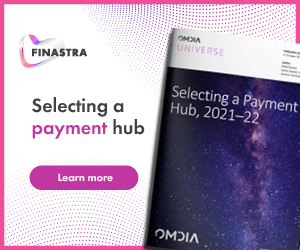
Africa’s Demand for Payment Hubs Rises to Address the Continent’s Interoperability Gap
by Séba Daher, Lead Solutions Consultant, Payments at Finastra 13 September 2022Africa is a world leader in mobile money, with Kenya and Ghana having the highest rates of mobile payment use in the world after China. The continent’s 55 countries are home to around 171 mobile money wallets, more than 1,000 banks and over 12 card networks – with little interoperability.
However, the accelerated digitalisation that swept the globe has led to widespread adoption of digital financial services. Regulators and governments have responded, rolling out intensive payment modernisation initiatives that are driving a lot of compliance pressure on banks.
Globally, customers – both individuals and businesses – now want their services fulfilled instantly, and that extends to cross-border settlements as well.
The big pain point? As of 2021, over 80% of pan-African cross-border payment transactions had to be routed offshore for clearing and settlement using international banking relationships. That posed multiple challenges, ranging from payment delays to operational inefficiencies and compliance concerns for the disparate regional payment systems.
Closing this gap is essential to increasing Africa’s competitiveness in global financial flows.
To fill the interoperability gap, payment hubs are fast becoming the default approach for banks to manage payments. A payments hub is a flexible platform that enables banks to build their own payments services that can integrate with multiple systems and channels, essentially breaking down the silos present in legacy structures.
In addition, these hubs enable banks to meet new requirements such as open application programming interfaces (APIs) that power open banking ecosystems.

image via Unsplash
African payment hub initiatives
Part of the game changing Africa Free Continental Trade Area (AfCFTA) plan is the new interconnected Pan-African Payment and Settlement System (PAPSS): a cross-border, financial market infrastructure enabling payment transactions across Africa.
Launched commercially in January 2022, PAPSS is projected to save Africa more than US$5 billion annually in payment transaction costs, according to PAPSS CEO Mike Ogbalu. PAPSS ensures instant or near-instant transfers of funds between originators in one African country and beneficiaries in another.
PAPSS also decreases the liquidity requirements of commercial banks for cross-border payments; and strengthens oversight of cross-border payment systems by central banks.
Meanwhile, the 16-member Southern African Development Community (SADC) has enabled Low Value Credit Transfers Cleared on an Immediate Basis (TCIB). This streamlines onboarding for banks and non-banks such as mobile money operators and remittance service providers in the low-value credit scheme, to support the transfer of cross-border remittances.
Furthermore, SADC-RTGS — an real-time gross settlement (RTGS) system operated by the South African Reserve Bank (SARB) — is set to migrate to ISO 20022.
Post-pandemic, there has been a marked increase in real-time payments initiatives in multiple African jurisdictions. In late 2021, the Central Bank of Egypt launched the Instant Payment Network (IPN), which is operated by Egyptian Banks Company (EBC). In Morocco, a joint effort between Bank al Maghrib and the Group for a Moroccan Interbank Clearing System (GSMIT) has birthed an instant payments platform.
In South Africa, SARB is working on a new Rapid Payments Programme (RPP) that will offer a cost-effective instant payment service across banks, a proxy service to embed user banking details, a request to pay service, as well as support for several known retail payment use cases.
South Africa is also setting the pace for modernising domestic payment infrastructure, with the imminent launch of modernised South African Multiple Options Settlement (SAMOS), an RTGS system owned and operated by the SARB. This is part of South Africa’s National Payment System Framework and Strategy Vision 2025.
All these initiatives — whether Pan-African or run by individual jurisdictions — are catalysts for African banks to adopt payment hub solutions to address immediate needs, while also building a strong foundation for a larger and long-term payment transformation organisation-wide to better compete on a regional and global scale.
Finastra snags payments hub leader mantle
Payment hubs consolidate all payment streams into a single central, standardised and coordinated platform, improving control, visibility and efficiency, as well as reducing complexity.
In its “Selecting a Payment Hub, 2021-22” report, technology research firm Omdia Universe estimated that by 2025, global spend on payment hubs will reach US$2.6 billion, growing at a compound annual growth rate (CAGR) of 8% between 2020 to 2025.
The 2021 study conducted by the firm, which polled payment issuers/acquirers, found that 29% of respondents identified payment hubs as one their top three IT projects.
Omdia noted that banks need to understand the capabilities and limitations of various payment hubs to implement the correct strategic approach to enable their payment transformation ambitions.
Its report also highlighted leading payment hub platforms and providers, naming London-based Finastra as a market leader due to its wide breadth of
functionalities that are available off-the-shelf and can be deployed flexibly.
Supported by the broadest and deepest portfolio of financial services software, Finastra delivers this vitally important technology to financial institutions of all sizes across the globe, including 90 of the world’s top 100 banks.
Finastra has a large ecosystem of fintech partners through its collaboration platform, which is integrated with the payment hub solution. The vendor also scored highly across several categories and has been praised by customers for its excellent customer support and collaborative approach to designing its product roadmap.
Finastra’s payment hub solutions in Africa
Within the Pan-African region, Finastra’s payment hub offerings are led by Fusion Global PAYplus (Fusion GPP), an omnichannel payments hub, providing domestic and international order management, payment
processing, and payment execution functionality across a broad range of payment instruments.
Fusion GPP primarily targets Tier 1 and Tier 2 banks, while its software-as-a-service cloud solution Fusion Payments To Go addresses payment hub needs for mid- to low-tier banks.
Africa’s payments market will only continue to grow, and so Pan-African banks and organisations looking to centralise and unify all their digital payments needs in a single hub, will be looking for solutions that give them scalability and flexibility to expand their offerings to respond to newer trends.
Finastra’s large partner ecosystem enables banks and fintechs to offer additional services through third parties which can be pre-configured for easy deployment, and thus can tap this partner ecosystem to broaden their platform solution capabilities.
Download Omdia’s report to help you achieve your payment transformation ambitions by selecting the best payment hub here.
Featured image credit: Edited from Unsplash







No Comments so far
Jump into a conversationNo Comments Yet!
You can be the one to start a conversation.